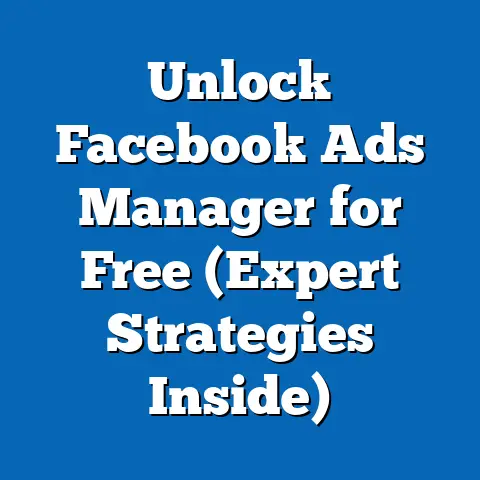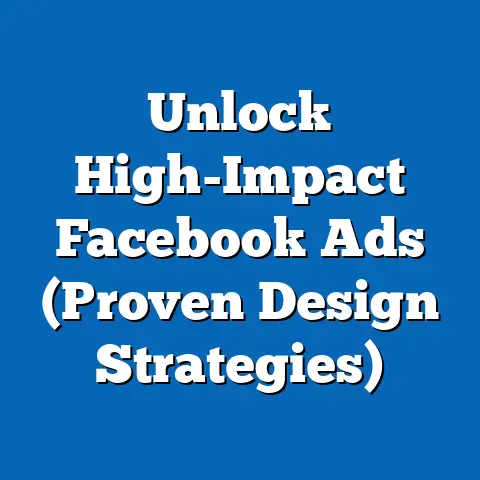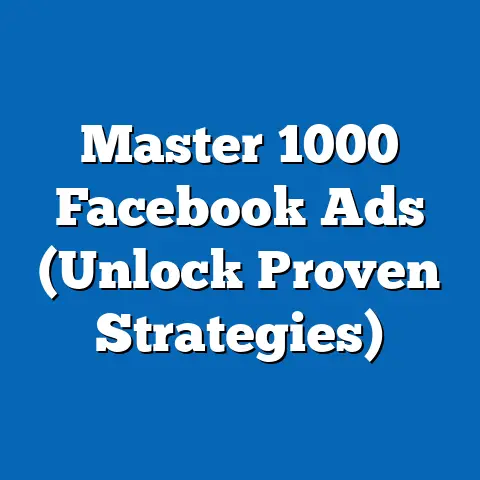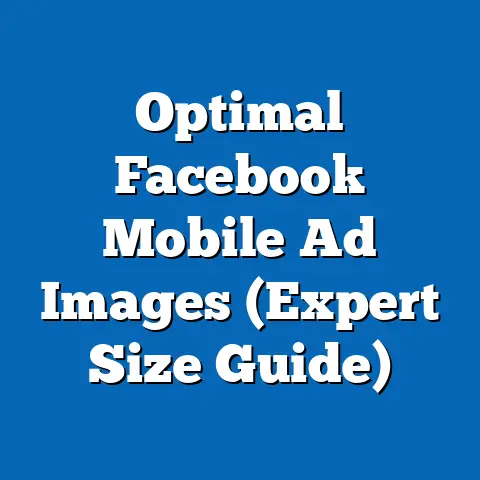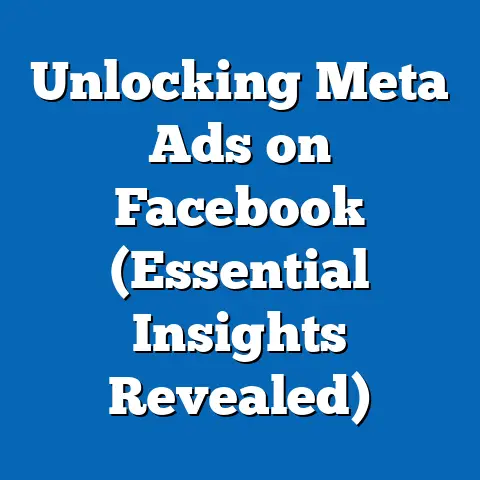Transform Facebook Lead Ads Without a Website (Expert Strategies)
In today’s hyper-connected world, the way businesses engage with potential customers has evolved dramatically, driven by shifting lifestyle needs and technological advancements. For many modern consumers, particularly across younger generations like Millennials and Gen Z, the demand for instant gratification, seamless user experiences, and mobile-first solutions shapes their interaction with brands. These lifestyle preferences—rooted in a fast-paced, digitally integrated society—have pushed marketers to rethink traditional lead generation strategies, including the reliance on websites as the primary landing point for campaigns.
Lifestyle Needs and Generational Influences on Digital Engagement
The lifestyle needs of today’s consumers are heavily influenced by generational characteristics, which in turn shape their expectations from digital platforms like Facebook. Millennials (born 1981–1996) and Gen Z (born 1997–2012), who collectively dominate social media usage, prioritize convenience, authenticity, and speed in their interactions with brands. According to a 2022 Pew Research Center study, 54% of Gen Z and 48% of Millennials access social media multiple times a day, often using mobile devices as their primary gateway to the internet.
These generations grew up during periods of rapid technological advancement, with Millennials witnessing the rise of the internet and Gen Z being true digital natives. Historical events like the 2008 financial crisis for Millennials instilled a sense of economic pragmatism, while Gen Z’s formative years were marked by global challenges like climate change and the COVID-19 pandemic, fostering a preference for transparency and purpose-driven brands. Their shared reliance on mobile technology means that long, cumbersome processes—such as navigating to a website to fill out a form—are often seen as barriers rather than conveniences.
Societally, this shift reflects a broader move toward immediacy and accessibility in digital interactions. The implication for businesses is clear: marketing strategies must adapt to meet users where they are, often within the confines of a single app or platform. Facebook Lead Ads, with their ability to capture information directly within the platform, cater to these needs by reducing friction and aligning with the on-the-go lifestyles of modern consumers.
Historical Context: The Evolution of Lead Generation in the Digital Era
To fully appreciate the significance of transforming Facebook Lead Ads without a website, it’s essential to understand the historical trajectory of lead generation. In the early 2000s, the rise of websites as central hubs for businesses marked the first wave of digital marketing, where static landing pages and email sign-ups were the norm. This era, dominated by desktop internet usage, saw marketers funneling traffic to websites to capture leads, often requiring significant investments in web design and SEO.
The advent of social media in the late 2000s, with platforms like Facebook launching in 2004, shifted the landscape by introducing new ways to engage audiences directly. By 2015, Facebook introduced Lead Ads, a game-changing tool that allowed businesses to collect user information without redirecting them to an external site. This innovation coincided with the mobile internet boom—Pew Research notes that smartphone ownership in the U.S. surged from 35% in 2011 to 81% by 2019—highlighting a growing preference for in-app experiences over traditional web browsing.
Historically, the reliance on websites often created bottlenecks, especially for small businesses or solopreneurs lacking the resources to build and maintain professional sites. The societal implication of this shift toward website-less strategies is a democratization of marketing, enabling even micro-businesses to compete in the digital space. Today, as consumer behavior continues to prioritize speed and simplicity, leveraging tools like Facebook Lead Ads without a website isn’t just a trend—it’s a strategic necessity.
Defining Characteristics of Modern Lead Generation Audiences
Understanding the audience for Facebook Lead Ads requires a nuanced look at their defining characteristics across technological, economic, social, and cultural dimensions. Technologically, the target demographic is mobile-savvy, with a 2023 Statista report indicating that 60% of social media users access platforms exclusively via mobile devices. This reliance on smartphones underscores the need for campaigns that function seamlessly within apps, bypassing the need for external websites.
Economically, many in this audience—particularly younger users—value cost-effective solutions and are wary of overpaying for services, a trait shaped by economic uncertainties in their formative years. Socially, they seek connection and trust, often relying on peer reviews and influencer endorsements over traditional advertising. Culturally, there’s a growing emphasis on personalization and relevance; a 2022 McKinsey study found that 71% of consumers expect tailored interactions from brands, and 76% get frustrated when this expectation isn’t met.
These characteristics highlight the diversity within the audience, as not all users share identical priorities or behaviors. For instance, while Gen Z may prioritize visual storytelling on platforms like Instagram (owned by Meta, Facebook’s parent company), Millennials might respond better to value-driven messaging. Marketers must account for these nuances when designing Lead Ad campaigns, ensuring they resonate on a personal level without relying on a website as a crutch.
Societal Implications of Website-Less Lead Generation
The move toward website-less lead generation via platforms like Facebook has far-reaching implications for society and business ecosystems. On one hand, it lowers the barrier to entry for entrepreneurs and small businesses, fostering innovation and competition in markets previously dominated by larger players with robust online presences. A 2021 Small Business Administration report noted that 44% of small businesses in the U.S. lack a website, often due to cost or technical barriers—tools like Facebook Lead Ads offer a viable alternative.
On the other hand, this trend raises concerns about data privacy and consumer trust. When leads are captured directly on social platforms, users may question how their information is stored and used, especially given high-profile data scandals involving Meta. Societally, this could exacerbate existing tensions around digital surveillance and personal autonomy, necessitating transparent communication from businesses about data handling practices.
Additionally, the shift away from websites may impact how brands build long-term relationships with customers. Websites often serve as comprehensive hubs for storytelling, product information, and customer support—without them, businesses risk losing depth in their engagement. Balancing the immediacy of Lead Ads with strategies to maintain trust and connection will be critical for sustainable success.
Expert Strategies for Transforming Facebook Lead Ads Without a Website
Having established the context and implications of website-less lead generation, let’s dive into expert strategies for maximizing the potential of Facebook Lead Ads. These approaches are designed to align with modern consumer needs while addressing the challenges of operating without a traditional web presence. Each strategy is supported by data, case studies, and practical insights to ensure actionable outcomes.
1. Optimize for Mobile-First, In-App Experiences
Given the mobile dominance among target audiences, the first step is to ensure that Lead Ads are fully optimized for in-app functionality. This means crafting concise, visually appealing forms that auto-populate user data (like name and email) directly from their Facebook profiles, minimizing manual input. According to Meta’s own data, Lead Ads can reduce cost-per-lead by up to 20% compared to traditional web-based campaigns due to this reduced friction.
For example, a small fitness coaching business used Lead Ads to offer a free workout plan, capturing over 500 leads in one week without a website. The ad featured a simple call-to-action (“Get Your Free Plan”) and a two-field form, ensuring users could sign up in seconds. Marketers should test different form lengths and designs to find the sweet spot between data collection and user convenience.
2. Leverage Instant Follow-Up Mechanisms
Without a website to direct users to, immediate follow-up is crucial to maintain engagement after a lead is captured. Experts recommend integrating tools like CRM systems (e.g., HubSpot or Mailchimp) or automated messaging via Facebook Messenger to deliver instant value. A 2023 HubSpot report found that leads contacted within five minutes of submission are 9 times more likely to convert.
For instance, an online course creator used Lead Ads to collect sign-ups for a webinar, automatically sending a confirmation message with a calendar link via Messenger. This not only confirmed the lead’s interest but also provided a seamless next step without requiring a website. Businesses should prioritize automation to ensure no lead falls through the cracks, especially in the absence of a central web hub.
3. Utilize Rich Media and Storytelling Within Ads
One challenge of forgoing a website is the loss of space for detailed brand storytelling. To counter this, marketers can embed compelling narratives directly into Lead Ads using rich media like videos, carousels, or interactive images. A 2022 Social Media Examiner study revealed that video ads on Facebook generate 59% more engagement than static images, making them a powerful tool for lead capture.
Consider a local bakery that used a short video in their Lead Ad to showcase their baking process and offer a discount code upon form submission. The ad not only captured leads but also built an emotional connection, compensating for the lack of a website. Marketers should focus on authenticity and value in their storytelling, ensuring the ad itself feels like a complete experience.
4. Build Trust Through Transparency and Social Proof
Without a website to establish credibility, trust-building becomes paramount in Lead Ad campaigns. Including social proof—such as customer testimonials, ratings, or influencer endorsements—directly in the ad can address this gap. Additionally, clear language about data usage (e.g., “We’ll only use your email for this offer”) can alleviate privacy concerns.
A real estate agent, for example, ran a Lead Ad campaign offering a free home-buying guide, featuring a testimonial from a past client in the ad copy. This small addition increased their conversion rate by 15%, as reported in a 2023 case study by Meta. Businesses should also link their Facebook Page to the ad, providing a verifiable presence even without a website.
5. Experiment with Lead Magnets and Value Offers
A strong lead magnet—an incentive for users to share their information—is critical when there’s no website to provide additional context. Experts suggest offering high-value, low-commitment items like eBooks, checklists, or exclusive discounts that can be delivered via email or Messenger. According to a 2021 Content Marketing Institute survey, 67% of marketers find lead magnets effective for capturing high-quality leads.
For example, a freelance graphic designer offered a free design template via a Lead Ad, delivering it through a pre-set email sequence. This not only generated leads but also positioned the designer as an authority without a website. Testing different lead magnets tailored to the audience’s pain points can significantly boost campaign performance.
6. Use Retargeting to Re-Engage Leads
Without a website for remarketing pixels, businesses must rely on Facebook’s built-in retargeting tools to re-engage leads who don’t convert immediately. Custom Audiences, created from Lead Ad submissions, allow marketers to serve follow-up ads to these users, reinforcing the initial offer. Meta reports that retargeting campaigns can increase conversion rates by up to 70% when executed effectively.
A pet supply store, for instance, retargeted users who submitted a Lead Ad form for a free pet care guide but didn’t purchase, offering a limited-time discount. This strategy resulted in a 25% uplift in sales over a month. Marketers should craft retargeting ads that build on the original value proposition, ensuring consistency in messaging.
7. Monitor and Optimize with Data Analytics
Finally, continuous optimization is key to success with Lead Ads, especially without a website to track broader user behavior. Facebook’s Ads Manager provides detailed insights into form completion rates, cost-per-lead, and audience demographics, enabling data-driven adjustments. A 2023 Forrester study emphasized that businesses using analytics to refine social media campaigns see a 30% higher ROI on average.
Marketers should set clear KPIs (e.g., target cost-per-lead) and run A/B tests on ad creatives, form fields, and audiences to identify what works best. Regular analysis ensures campaigns remain aligned with evolving consumer preferences, compensating for the lack of website analytics.
Comparative Analysis: Website-Based vs. Website-Less Lead Generation
Comparing traditional website-based lead generation with website-less strategies reveals distinct advantages and trade-offs. Website-based approaches offer depth—detailed content, SEO benefits, and comprehensive tracking—but require significant time and financial investment. They’re ideal for established brands with resources to maintain a robust online presence.
In contrast, website-less campaigns via Facebook Lead Ads prioritize speed and accessibility, catering to mobile-first audiences and resource-constrained businesses. However, they lack the storytelling space and long-term branding potential of websites, requiring marketers to be more creative within platform constraints. Data from a 2022 Meta study shows that Lead Ads achieve 13% higher conversion rates for mobile users compared to web-based forms, underscoring their effectiveness in specific contexts.
The diversity within target audiences also plays a role; older demographics like Gen X may still prefer website interactions for trust and detail, while younger users embrace in-app simplicity. Businesses must weigh these factors, potentially adopting hybrid models where budgets allow, to balance immediacy with depth.
Technological, Economic, and Cultural Factors Driving the Shift
Several macro-level factors underpin the move toward website-less lead generation. Technologically, the proliferation of mobile devices and app-based ecosystems has redefined user expectations, with platforms like Facebook becoming self-contained environments for discovery and transaction. Economically, the high cost of website development—often $2,000 to $10,000 for small businesses, per a 2023 Clutch survey—pushes entrepreneurs toward cost-effective alternatives like Lead Ads.
Culturally, the emphasis on instant results and minimal effort aligns with generational values of efficiency and pragmatism, particularly among Millennials and Gen Z. Socially, the growing influence of social media as a primary information source—Statista notes that 31% of U.S. adults get news from social platforms—reinforces the centrality of in-app engagement. These converging factors suggest that website-less strategies are not a passing fad but a reflection of deeper societal shifts.
Implications for Businesses, Consumers, and Society
For businesses, adopting website-less Lead Ad strategies can accelerate growth by reducing overheads and reaching audiences directly, but it demands agility in follow-up and trust-building. Small businesses and solopreneurs stand to gain the most, as they can compete without the traditional digital infrastructure. However, larger brands may struggle to maintain narrative control without websites, necessitating complementary tactics.
Consumers benefit from streamlined experiences that match their lifestyle needs, but they face risks around data privacy and limited access to detailed brand information. Societally, this trend could widen digital inclusion by empowering micro-entrepreneurs, yet it may also deepen reliance on a few dominant platforms like Meta, raising questions about market concentration and data ethics.
In the workplace, marketing teams must adapt to new skill sets focused on in-platform creativity and analytics, potentially reshaping hiring and training priorities. The cultural impact includes a redefinition of “presence”—where a brand’s identity is increasingly tied to social media rather than a standalone digital home.
Conclusion: Forward-Looking Insights and Uncertainties
Transforming Facebook Lead Ads without a website represents a pivotal adaptation to modern consumer behaviors, driven by lifestyle needs, technological trends, and economic realities. The expert strategies outlined—optimizing for mobile, leveraging instant follow-ups, and building trust through transparency—offer a roadmap for businesses to thrive in this space. Data and case studies affirm the efficacy of these approaches, particularly for small enterprises and mobile-first audiences.
Looking ahead, the trajectory of website-less marketing will likely accelerate as mobile usage grows and platforms enhance in-app capabilities. However, uncertainties remain, including evolving privacy regulations (e.g., GDPR, CCPA) that could restrict data collection practices, and potential shifts in user trust toward social platforms. Businesses must stay vigilant, balancing innovation with ethical considerations to sustain long-term success.
Ultimately, while website-less strategies are not a one-size-fits-all solution, they reflect a broader reimagining of how connection and commerce occur in the digital age. By embracing these changes with nuance and foresight, marketers can meet today’s demands while preparing for tomorrow’s challenges.

